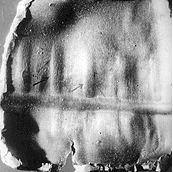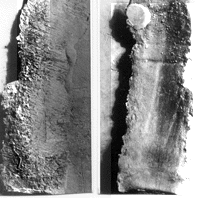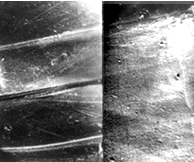

|
The possibility of utilising marks other than the usual rifling marks to identify lead core and jacket pieces having decipherable interference marks, has been investigated. Deep engravings of rifling marks have been found to have impressions , in some cases, on the under surface of the jacket and on the lead core which normally remain even when the upper jacket surface suffers considerable deformation and fragmentation .Such marks can be utilised to eliminate or to link the lead core and otherwise nonidentifiable jacket pieces with the suspect firearm. Introduction Bullets fired from high powered rifles very often fragment inside the body or on impact with other objects. The nature and extent of fragmentation depend upon striking energy, the path traveled , the target, etc. Fragmentation may lead to the complete separation of the lead core and its further fragmentation. Due to impact and striking various objects, the rifling marks on the portion of the bullet may be masked, obliterated or interfered with. The jacket pieces with additional rubbing and impact marks, may not be identifiable even to the extent of elimination on the basis of class characteristics although initially they bore characteristic rifling marks. The possibility of utilizing marks other than the usual rifling marks to identify lead core and otherwise non-identifiable jacket pieces ,is discussed in the present paper. When a bullet is fired through a rifled firearm, it is engraved with the characteristic land and groove marks of the barrel. The depth and the nature of the engraving depends upon the condition of the rifling(worn or not), surface irregularities of the barrel, diameter of the bullet, "set-up" of the bullet in the barrel, construction material of the bullet etc. Some of the deeper engravings are likely to leave an impression on the under surface of the jacket and on the portion of the lead core which is in close contact with the under surface of the jacket. Marks on the upper jacket surface due to impact and rubbing are not expected to have a significant influence on the under surface of the jacket and on the lead core unless they also come in the direct contact with the striking objects, or unless the engravings due to rubbing and impact on the upper jacket are deeper than the engravings due to rifling. These marks whenever present can therefore be of great significance where the normal identification procedure is not possible. Experimental To study the marks on the undersurface of the jacket and on the lead core, experimental firings were conducted with high powered rifles. Jackets of the recovered bullets were cut open and the lead cores were removed. A few rounds were fired so that the bullets hit the sides of the iron lining of the bullet recovery, thereby causing splintering of the bullet. In addition, bullet fragments from actual cases and control unfired bullets were also studied . Results and discussion Examination of the under surface of the jacket and the lead core revealed in some cases, the presence of identifiable characteristic rifling marks. The engravings in most of these were sufficient for the identification of class characteristics (direction of rifling, angle of rifling, width of rifling, etc.) (Fig.1). The deeper engravings of the individual marks were found to be either absent or insufficient excepting in a very few cases ( Fig.2). However, the impressions were usually found to be retained even on fragmented pieces (Fig.3). In fact the marks were clear especially on the lead core when the bullets were flattened due to heavy impact. However, examination of these marks involves further allied problems which must be considered , otherwise results may be misleading. |


|


|
|
Marks on the under surface of the jacket
Impressions on the under surface of the jacket are the negative profile of the rifling marks on the bullet. Consequently the direction of rifling is reversed, i.e. left handed rifling appears as right handed rifling and vice versa. Similarly, grooves appear as lands, and striations are at 180 degree phase difference (Fig. 1 arrow). The examination and comparison of rifling marks on the bullet, therefore, involve positive/negative comparison and due caution must be exercised.  a b (b) Class characteristic rifling marks on the under surface of the jacket of the same piece. Marks on lead core Marks on the lead core are a positive reproduction of the rifling marks on the upper jacket surface . As such, the characteristic marks on the lead core can be examined and compared with the rifling marks on the test bullets by usual procedure. These marks are of great use in cases where jacket pieces are not available, irregular lead pieces only from the evidence and it is necessary to ascertain whether the questioned pieces are from spherical lead shot or from lead core and, if from lead core ,the probable bullet caliber. In a murder case, on the basis of the width and number of lands and grooves imprinted on a badly mutilated lead core ( the only piece of evidence), it was possible to eliminate one of two suspected rifles having different rifling specifications (Fig.4). Sufficient individual characteristic striations, although rare, could also be utilised for linkage with the suspected firearm ( Fig. 5). 
Fig.4 Class characteristic marks on the lead core with the test bullet  Fig.5. Striations matching of the individual characteristic marks on the lead core(left)with the test bullet(right). |
|
FORENSIC FIREARM PAGE |